The last few generations have seen an exodus of people from mountains, jungles, islands, farms and rural areas heading into cities seeking opportunities. Only a few decades ago the vast population of Thailand lived outside cities, often in remote areas with substandard education, health, infrastructure and with little chance for betterment. Interestingly a report by UNESCO revealed that while 50% of Thais now live in cities, the migration numbers from rural areas to cities have dropped consistently from 2.2% in 2012 to 1% in 2016.
This month we bring you inspiring stories of four people who left home for the glittering promises of big cities only to decide to return to their roots. Whether it is an Akha coffee lover who has created jobs and opportunities for hundreds of his villagers, a Karen musician reintroducing a rare musical instrument to the world who has opened a successful City Slicker type homestay, a young woman who is on a mission to make local cuisine cool again or a weaver from Doi Tao who has created a local industry, these are people who saw potential in their heritage and have realised that potential in successful ways. Meet the cool kids who brought the world to their doorstep.
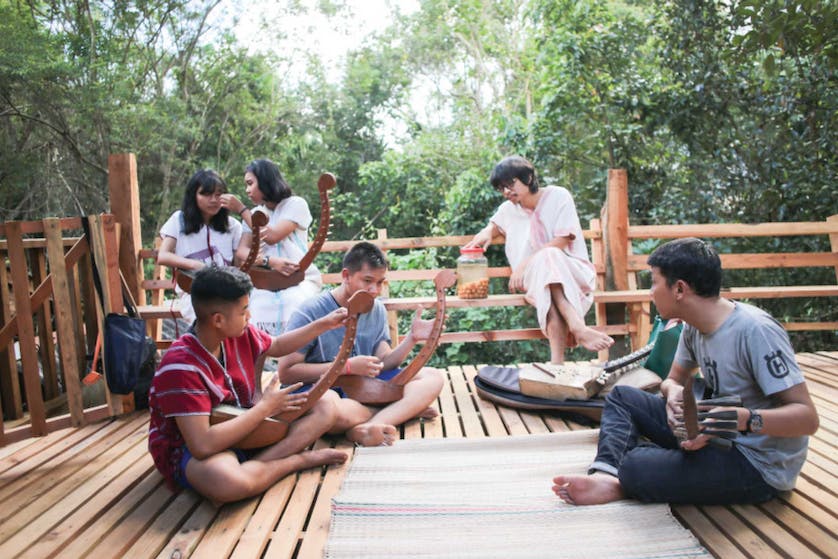
Weaving the Cultural Bond
In Karen tradition, men are not allowed to weave clothes, the skill being relegated to the woman’s domain. So who would have thought that a man can play a significant role in not only sustaining the weaving skills of his community, but growt it into an industry. Chankum ‘Tuy’ Puped does not weave, though he dyes, spins and designs, and in spite of tradition has a great appreciation for textile, an important fabric of his heritage. Tuy, a petite man in his 40s, left his village at the age of 12 to find work. Moving from province to province and job to job he soon realised that he didn’t have much of a future in his various careers and while money was good, he missed home.
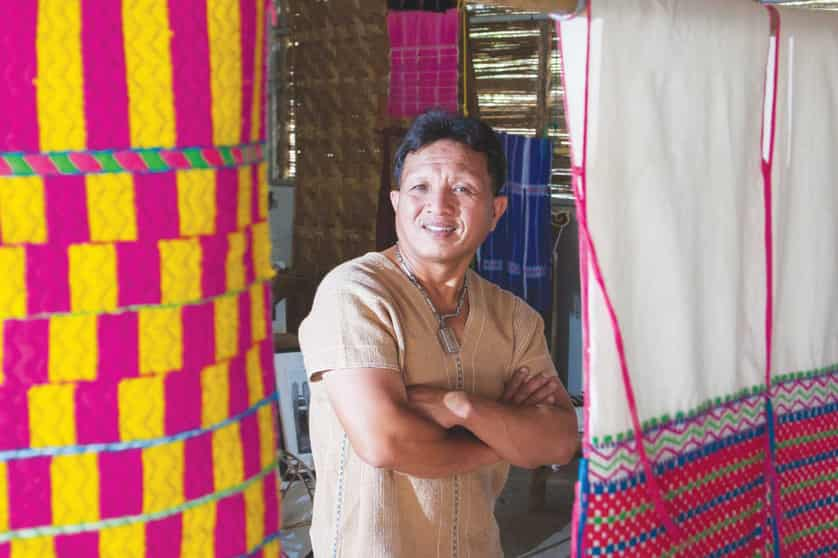
“I was but a man with low education,” said Tuy who moved home in 1992. “My father was the village headman and I began to envision my village’s future. What I saw was that our clothes were disappearing; young generations preferring jeans and t-shirts to traditional woven clothes. So I decided to apply for a grant from the Thai-German Institute to set up an occupational group. We received, I think, about 20,000 baht and some staff who came to support the set up and help us find a market.” The group began with a mere five weavers which included Tuy’s grandmother.
“I soon learned that what we did wasn’t just about fabric. We were weaving our story, beliefs and culture together. You see, the pattern is as limited as the weaver’s imagination and each piece has a very sentimental value,” said Tuy, explaining that a person wearing the clothes should know the name, traditions and background of the pattern.
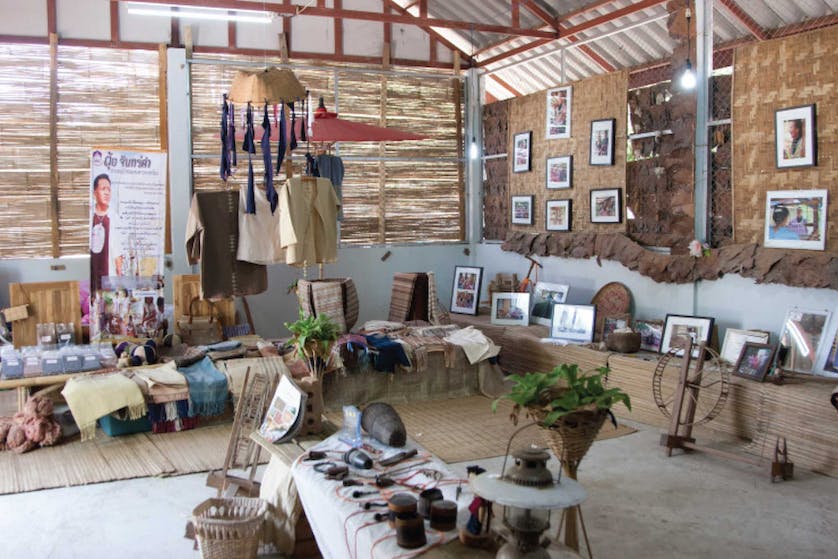
It wasn’t an easy journey, and Tuy used to spend his time carrying a sack packed with Karen clothes, knocking on doors along Tha Pae Road and the Night Bazaar, peddling his products. It was a tough time, he admitted, as the distinctive designs weren’t generally popular and the rough texture of the thread off putting to many people. One day Tuy met with Nittaya Mahachaiwong of the Knowledge and Technology Center for Local Textile, Chiang Mai University, also known as Fai Gaem Mai. Soon Fai Gaem Mai was providing him with the skills needed to make his products attractive to a larger market as well as helped him to explore marketing opportunities.
In 1996, Tuy set up a learning centre with support from ThaiCraft, a social enterprise, with the aim of building a connection between village weavers and youths. Youths of all ages were provided the opportunity to develop an understanding of weaving starting at basics from preparing the cotton, threading, dying through to weaving. Today, with a focus on original and traditional textiles and natural dyes, the Ban Lai Kaew Karen group has grown to encompass around 50 weaver members which expands to a network of almost one hundred households across several villages. Weavers from as young as 15 are now eager to learn traditional skills as well as have the chance to make some extra money.

“What I am working on now is to shape human resources to have skills in management and I want this learning centre to be able to provide them with a steady job with a regular salary. Right now this place depends solely on me and it needs to be able to run on its own. I don’t expect to change anyone’s mind about their career path, but I want them to know that our clothes are our identity and that they can always return home one day where there is knowledge to be passed on and opportunities to be explored.”
Facebook: weaversdoitao
Akha Ama’s Giant Strides
In 2011 for our article ‘Underdog’, Citylife sat down with aspiring entrepreneur Lee Ayu Chuepa who had recently founded a social enterprise named Akha Ama to help elevate prospects for his Akha village in Mae Chan Tai, Chiang Rai, citing the need to demand fair pricing from coffee buyers as well as the importance of expansion from the risks of monocrops.
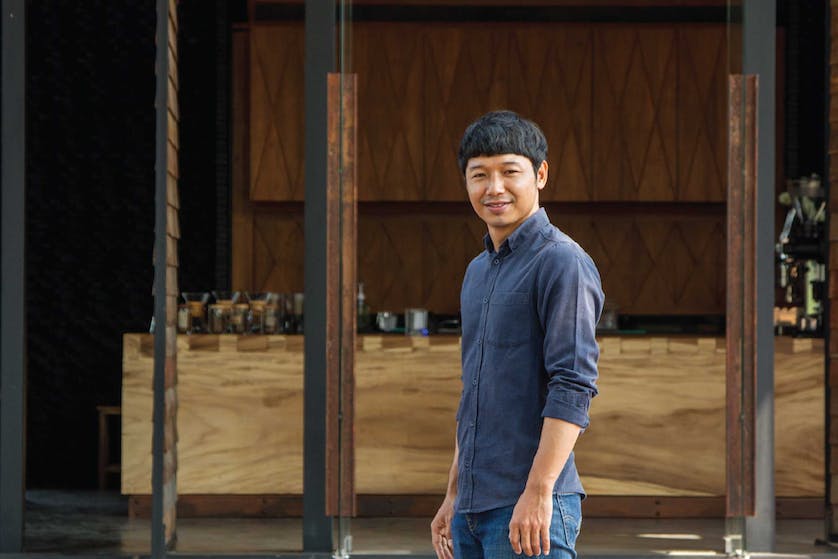
“Yeah, wow that feels like a long time ago,” said Lee sentimentally. “We were just starting out and I had a three year plan to grow Akha Ama to the point where it could stand on its own two feet. Everything was new back then and coffee wasn’t the massive industry it is today. In fact, people didn’t even know what social enterprise was, with its image at the time being of projects initiated by rich people with spare change which never sustained itself,” said Lee while pointing out that the Thai Social Enterprise Office established in the same year as Akha Ama in 2010. “In our third year, the coffee market started kicking off and that was about the time when I wanted Akha Ama to become a model for other coffee enterprises. I began to think about branding and when I had the opportunity to visit Portland Oregon’s Stomptown Coffee Roaster, to learn cupping and tasting skills, the international media showed interest in what I was doing which then led to the interest of the Thai media helping to grow the enterprise,” Lee continued.

“I began to notice that people were interested in not just a cup of coffee, but the culture and story behind it so I initiated a project which has turned into Project Long to invite interested people back to my village for two weeks to exchange knowledge with farmers. They work alongside farmers from collecting coffee beans, stocking, roasting through to fermentation and throughout the process they are asked to collect data and document it to be distributed for further development or in decision making of farmers. It was really heart-warming to see consultants, engineers, baristas, investors and the curious of all nationalities getting along and having a great time discussing techniques, learning about local wisdoms and getting to meet the actual people toiling behind the scenes who produce the coffee we drink daily. I was amazed to learn that it wasn’t just coffee they were interested in, but the food and culture. People really enjoyed cooking with my mother, hunting for local ingredients and sharing life experiences.” It was from this feedback that Lee began to see a greater potential for his enterprise.
“Akha Ama is a coffee brand. We make that clear but behind the coffee, there are numerous things going on that have an impact on the agriculture as a whole,” said Lee. Like any other plant, coffee needs to grow alongside other trees or plants to balance out the ecosystem in order to prevent diseases, bugs, and to foster the soil quality.
“The good thing about agriculture is that the product is obvious and clear, something important to the success of a social enterprise,” explained Lee. “Many social enterprises sell sympathy, relying heavily on donation money which doesn’t allow for continued investment and development. Eventually, they die. But in agriculture, to maintain sustainability means you need biodiversity. You can plant Chinese pear, persimmon, Indian gooseberry and many other crops along with coffee to expand your product line and there are interesting ways and natural ways to grow them organically which also generates food. Spare foods will allow farmers to generate more income, have more stability and be able to invest in growth. What I eat, I grow and hopefully it will inspire people.”
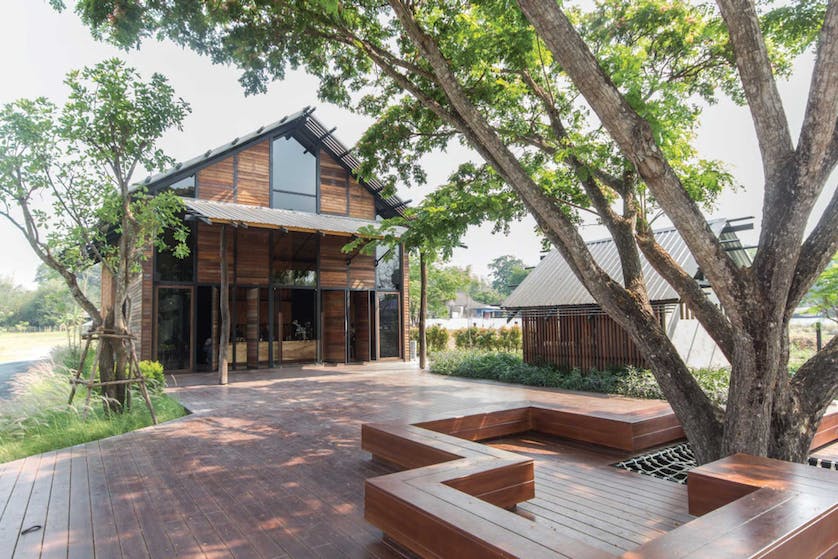
In February, Akha Ama Living Factory was established, the realisation of Lee’s dreams and a location which combines his warehouse, coffee roaster and a learning space. There will also be an experimental space for food with a kitchen and garden supplying produce to focus on indigenous ingredients and local food.
“Food bonds with our lifestyle and represents our culture. Deep inside, people crave good food and coffee is a food after all,” said Lee.
It’s been eight years since the establishment of Akha Ama and the social enterprise today produces over 30 tonnes of coffee a year receiving supplies from 20 households in five communities, creating an economic impact on hundreds of people, generating generations of baristas, encouraging organic farms under its wings and making thousands of our city’s coffee drinkers happy. “There are now four or five coffee brands established in my village owned by people who once worked for Akha Ama. Initially all neighbours of my generation left home, but now they have almost all returned back to develop their farms. It’s kinda like, hey, if Lee can do it, well I can too. When they see that there’s opportunity for a future, they came back. I really do want people to be proud of being a farmer,” said Lee.
Kin Lum Kin Dee’s Comfort Food
“Northern food means home to me,” said Piyaporn ‘Sai’ Thammapunya, the owner of Kin Lum Kin Dee. “It’s heart-warming. All these memories of cooking with my mother in the kitchen and conversations at the dining table give me a sensation that no other food can fullfil.”

Growing up as the daughter of a Northern food vendor in a local market, Sai always had a strong bond with her family’s delicacies. She eats the typical sticky rice with northern food three times a day and is proud of it. “Ever since I was a kid, I was always sharing my mother’s food with my friends, often having to persuade them to try some,” said Sai. “When time came for me to go to college, I was thinking about going for food science but science had never been my thing, so I enrolled at Chiang Mai University’s Faculty of Mass Communication, where I picked up my knowledge in branding. This has proven to be very useful since my return home to work in the family business.”
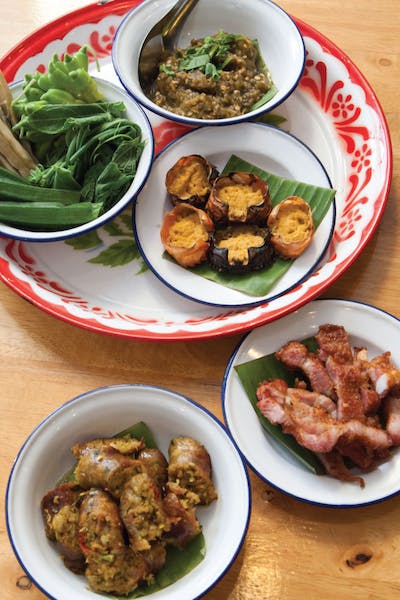
“People do not just eat for food anymore, they eat for image too. Remember five six years ago when everyone was flooding Facebook with Starbucks pictures? I was sick of that glorification of a global brand and a little bit annoyed that people didn’t rave over Northern foods. Our food is great, why aren’t we proud of it?” asked Sai. “I looked around at our markets with all the delicious products looking the same and realised that there was a lost connection between our food and our modern society. Young people don’t think it’s cool to go to the market anymore, preferring brands over taste. I realised that while my family’s food is undoubtedly delicious, it simply needed branding.” So in 2015 she launched Kin Lum Kin Dee, creating a strong brand and edgy packaging. While maintaining her mother’s market based, she began to sell sai-ua, the spicy northern sausage under her new brand, online. The feedback was impressive and instant, and soon she was receiving orders from all over the country. After being singled out by Citra cosmetics brand in a project seeking young women who return home to develop their communities, demand skyrocketed.
Sai was invited by her old school to give a talk one day and was stricken to learn that many students didn’t even know some of the most basic northern dishes such as jor pakkad (Chinese cabbage soup) which is one of the most ubiquitous dishes in northern households. Mention of pu aong, a freshwater crab paste delicacy also met with bewilderment. “I decided to post a short text on Facebook about the origins of pu aong one day and the post received 4.8k likes. It made me realise that people really wanted to know about these things. That’s why it’s painful to see our rich local cuisine end at just the market. There is no food connection between generations anymore, so young people have lost that knowledge and pride. Good northern food is getting harder and harder to find and if fewer and fewer people pay attention to it, it’ll be gone. This is our food. If we don’t eat it who will?” asked Sai.

“Kin Lum Kin Dee’s mission is to share the tastes of original Northern Thai or Lanna cuisine with the world,” she says of her restaurant which sells some of her family’s specialties in Nimmanhaemin.
Facebook: Kinlumkindee
Spreading the Sound of Thana
“I grew up listening to my father’s thana,” said Klee Bho, a musician born in a Karen Village in Galyani Vadhana district, referring to the Karen arched harp. Even though there are around nine million Karen citizens worldwide, Klee suspects that there are only a few hundred people left in the world who can play this rare traditional musical instrument. “It makes sense because most of my fellow Karen in Myanmar end up having to hold a weapon instead of a musical instrument due to the constant war,” said Klee.
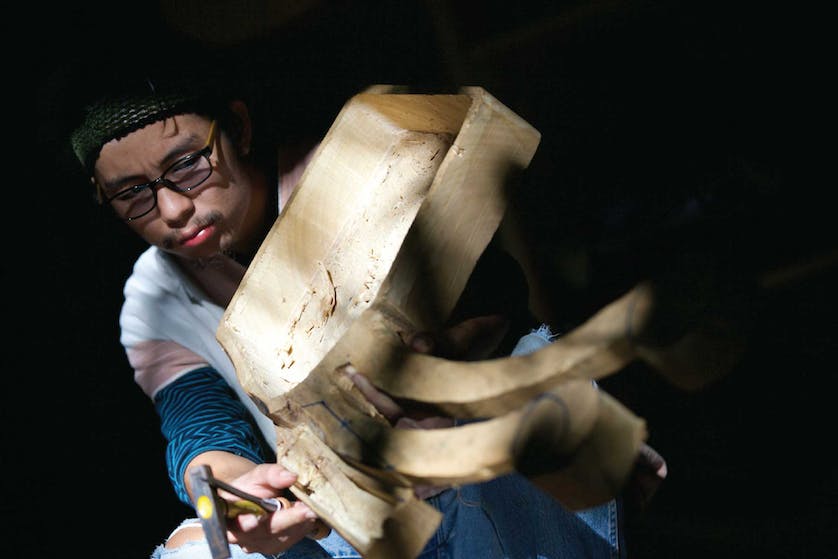
Thana delivers a soft, gentle, tinkling sound and is used in songs that tell stories of the Karen people — history, legend, lore, beliefs, wisdom passed down from ancestors — usually expressing their deep bond with nature. “It’s the way our ancestors used to teach their children. Our stories were delivered from mouth to mouth, from song to song. Now schools and universities are the new hope for families and communities,” Klee stated at TEDxChiangMai 2018 where he was a speaker. “Growing up, I didn’t pay much attention to thana as I thought It was boring,” explained Klee who being Christian grew up with church music. After graduation from high school he advanced his musical skills at Duliyasilp College of Music, Payap University where he picked up a variety of instruments including drums, guitar, trumpet and saxophone. “Other students picked one instrument to excel at, but I liked to experiment with many.”
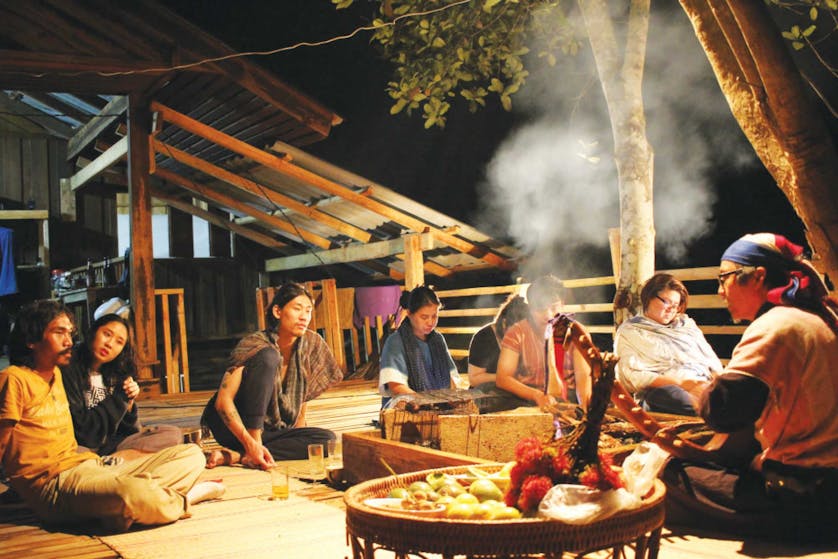
“For me the thana was always there. My father learned thana from a teacher who had gone into Karen State to learn skills and returned to teach at our village. I had listened to it for as long as I can remember, but honestly, the predictable melodies and rhymes didn’t charm me. So I thought if I was going to play it, I’d better make it suit my musical style,” said Klee who began to tinker with the bamboo instrument to adjust its sounds and functions as well as explore ways to weave it into his music. “This was when my knowledge of multiple instruments came in useful as it really helped me expand my creativity. It took me five years to really get there, adding an outlet for an amp, changing the material from bamboo to wood and such.”
Deciding that the ability to play the instrument wasn’t enough, Klee decided to pursue his Master’s Degree in Art and Cultural Management at Chiang Mai University. “I felt so proud when I proposed thana for every project at university; it got a lot of attention and the more interest it attracted the more potential I saw in it. So for my thesis I decided to study the thana, and I believe it may be one of the first pieces of academic research on the instrument in the world. Much of the research had to be done in the felid, as there were few documents and records available,” explained Klee who spent months talking to village elders and teachers of the instrument. He soon realised the depth of the bond between the thana and teaching and decided to teach himself. “I uploaded my lessons on YouTube though I will give free one on one lessons to anyone with real passion. One of my prides and joy was when a woman moving to US told me that she wanted to learn in order to teach the Karen people who live there,” smiled Klee who now wishes to spread the knowledge and skills of the thana far and wide.
“Now, I am happy at home scrubbing my passion fruit,” said Klee intriguingly.

Klee’s parents live in a very remote village and were initially very confused when he returned home with a Master’s Degree only to sit around playing the thana and polishing passion fruit…an odd pastime. Klee had a plan, however, and soon opened a homestay called Baan Phati, attracting city folks needing to escape to a simpler, if alien, lifestyle. “I put together a rough programme and soon we were seeing more visitors than we ever expected come to gawp at our mountain scenery with our stunning seas of mist. People came from Bangkok and beyond, working the fields harvesting rice, entering the jungles to collect wild mushrooms, go worm hunting, or simply sit around a camp fire on a quite chilly night under a sky full of stars. My parents were so shocked that our typical days could interest so many. What I offer is a genuine community life. I don’t try to fancy up my food, install a heater or build a toilet. Meanwhile other villagers also get a chance to join in selling souvenirs or rice and other products. In the evenings we gather by the fire pit where I play thana with my father and he gets to tell all of his stories. I’m just happy at home,” smiled Klee.
Facebook: Baanphati
